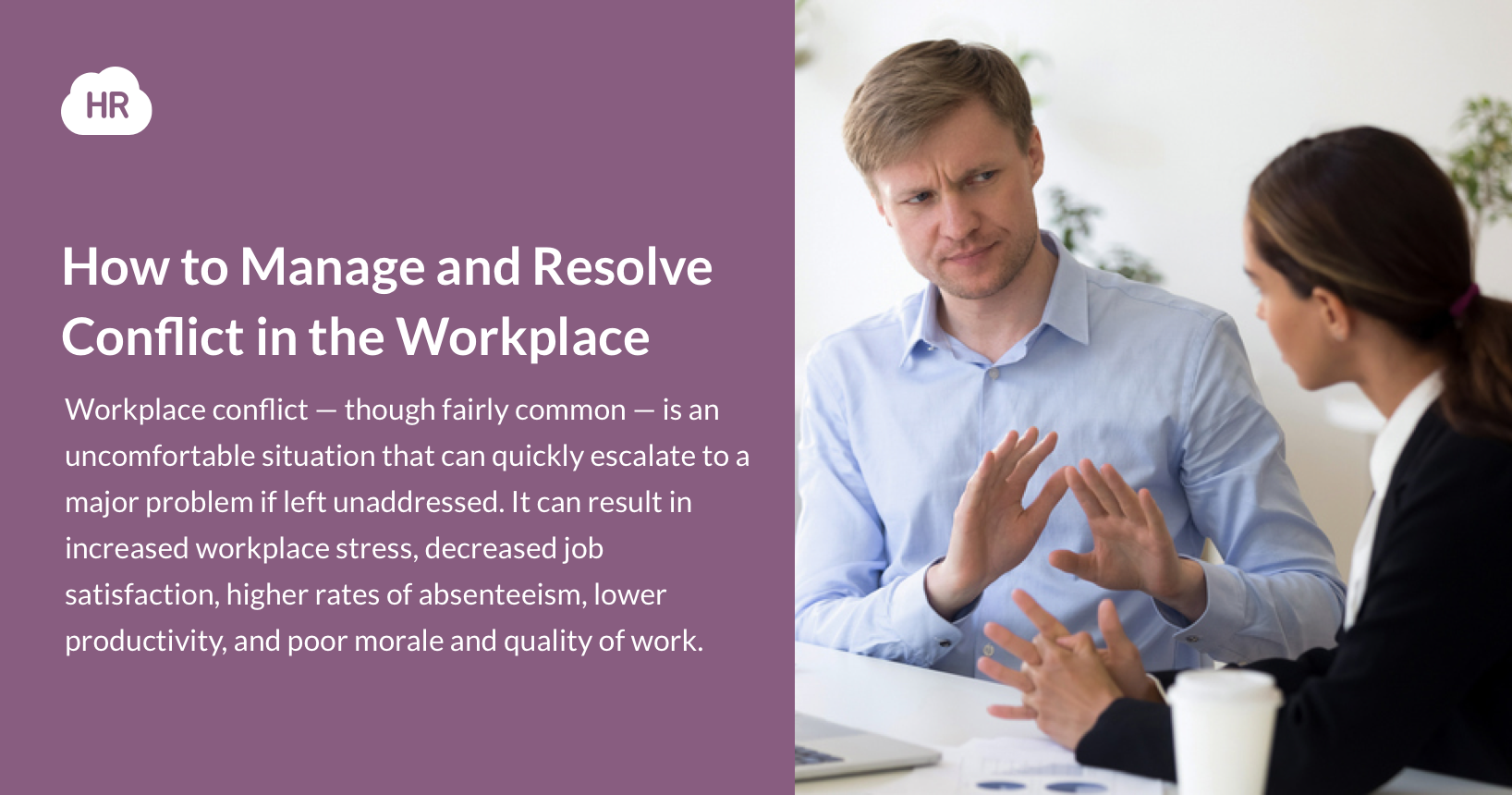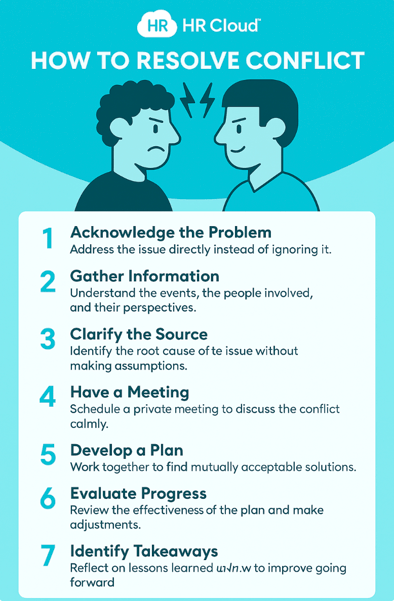How to Manage and Resolve Conflict in the Workplace | HR Cloud

Workplace conflict — though fairly common — is an uncomfortable situation that can quickly escalate to a major problem if left unaddressed. It can result in increased workplace stress, decreased job satisfaction, higher rates of absenteeism, lower productivity, and poor morale and quality of work.
But conflicts are inevitable. The idea is not to try to prevent them completely but to resolve and manage them effectively. When people use appropriate strategies to address issues, they’re able to keep their differences from getting out of hand.
“Establishing conflict management processes in a company is fundamental, as it helps reduce conflict instances among employees,'' says Casper Hansen, an expert in resume writing from resume that works.
Below is a step-by-step process to help you manage and resolve conflict in the workplace.
1. Acknowledge the problem.
Though the instinct may be to ignore the problem and hope it goes away, this strategy is rarely effective and often worsens the problem. Case in point: A 2019 survey of 30,000 employees found that nearly one in three people had left jobs due to workplace conflicts.
The best starting point is to accept that the problem exists. Face it head-on and commit to finding solutions.

2. Gather initial information.
Take time and investigate the case. Do not prejudge or come up with a final verdict before you have all the information. Dig deeper and find out more about the events, involved parties, issues, and how people are feeling.
Have an individual and confidential conversation with those involved and listen well to ensure you comprehend their viewpoints. You can do so by summarizing their statements and repeating them back to them.

3. Clarify the source of the conflict.
Next, clarify the nature of the issue with the parties involved. According to the team lead of Edu Jungles writing company Kevin Smith, finding the source of conflict is the main step to solve any problem.
Defining the root cause gives you important information of exactly what’s going on in the situation without assuming anything. Common causes of workplace conflict are:
-
Poor Communication: A lack of communication leads to feelings of exclusion or lack of control.
-
Lack of Skills: An employee may lack certain skills that another employee expects them to have, leading to issues with the delivery of work and affecting morale and confidence.
-
Insufficient Information: If an employee doesn’t have the necessary data to perform their job, they’ll feel frustrated. Similarly, if the information they have is ambiguous or incomplete, resentment may become an issue.
-
Remote Work: In the case of remote working, where communication has become largely text-based, there’s far more room for interpretation of tone than in face-to-face meetings. Managing conflicts in remote teams can be tricky, but can be simplified with employee communication software.
-
Differing Values: A difference in opinion and personal values may stir up conflict, especially if two strong personalities have opposing views.
If none of the above seem to apply, try finding an underlying source that may not be obvious at first. For example, an HR professional may believe someone has a bad attitude about a project because it comes with a heavier-than-usual workload.
However, approaching the person to learn more might reveal frustration with a colleague in another time zone. Or perhaps the problem centers around “urgent” requests the disgruntled individual consistently receives 15 minutes before the end of their workday.

4. Have a private and honest meeting.
Before trying to resolve any issue, find a safe, private, and neutral place to talk so that all parties involved feel free to participate in an open and honest discussion. Don’t choose the office of either party or a location near them.
Establish a positive and assertive approach. If necessary, set ground rules. Ensure that each side gets enough time to express their views — and feelings — regarding the matter. Creating time for people to publicly acknowledge hurt or anger can help them feel heard.
Then, get both parties to agree on what the issue is. Obtain as much information as possible on each side’s outlook. Continue asking questions until you’re confident that all the conflicting parties are on the same page.
5. Determine a goal and develop a plan.
Employees will find it easier to interact with one another if they realize that they have a common goal. Once that’s established, both parties should collaborate to develop a solution for the problem.
People approach conflict in various ways. A person may have one or more methods they prefer and use regularly. The Thomas-Kilmann Conflict Mode Instrument (TKI) is a psychological tool used to measure an individual’s inclination towards a specific method of handling conflict.
These are the five conflict resolution strategies from TKI.
-
Avoiding: Someone ignores the conflict or withdraws from it in hopes it will resolve itself or die down eventually. Oftentimes, this strategy is used when the discomfort of confrontation overshadows the potential reward of resolving the conflict.
-
Competing: An individual resolves a conflict by asserting their own interests and “winning” at the expense of the other party. It only works in situations that are not amenable to collaboration.
-
Accommodating: One party sacrifices their own concerns to meet the needs of the other party. This approach can appear to be a gracious way to concede, but it may also lead to unresolved issues if used excessively to maintain peace or avoid conflict.
-
Collaborating: This strategy involves working together to find a solution that meets the needs of all parties involved. This style is most effective when there is a need to find a mutually beneficial solution that requires a high degree of coordination.
-
Compromising: Parties that compromise are each willing to sacrifice something in order to reach an agreement. It’s the middle ground between competing and collaborating. In this strategy, every party gives up a bit of what they want and no one gets everything they want.
Find common ground and identify strategies each party can agree or compromise. Listen, communicate, and brainstorm together until you cover all options.
For example, maybe someone sensitive to noise says they need a quieter office mate. Start by figuring out which factors generate the biggest issues. Perhaps the person causing the bother simply has a voice that carries easily. If the upsetting sound level stems from a trait someone can’t help, the best option is probably to relocate them elsewhere.
However, if it’s behavior-based, maybe the person concerned could adjust their actions a bit. For example, the problem may be that a worker plays music through headphones, and the noise-sensitive person can still hear it. Asking the listener to turn down the volume, only listen to music for a half-day, or use an alternating quiet-hour system could offer possible compromises.
6. Evaluate how things are going.
Never presume that an issue is fully resolved after you set up a plan. Continue to keep an eye on the issue and assess if the solution is working. If necessary, schedule follow-up meetings to check progress.
Plan to meet about two weeks after finalizing an action plan to give everyone a chance to try out the solution and assess how it works. These gatherings should involve both parties and give them ample time to discuss the actions they’ve taken to end or ease the tension.
Urging people to stay open and honest about what leads to progress can keep them on track. Notes about what’s working well make it easier to motivate people to continue pursuing positive change, too.
But conflicts don’t always resolve after the first attempt. So if the issue isn’t resolved or later resurfaces, take necessary action. This can include coming up with preventative strategies for the future.
One effective way to reduce conflict is by implementing transparent feedback systems, such as a performance review tool, which makes it easier to address issues before they escalate.
7. Identify and Implement Key Takeaways
Lastly, look for lessons you can learn from the conflict and how you handled it. Reflecting on the conflict's resolution process offers valuable insights into the dynamics of your team, the effectiveness of your communication, and the resilience of your organizational structure.
You not only equip yourself with a better understanding of how to prevent future conflicts but also improve your ability to foster a more supportive work environment.
And documenting these lessons and sharing them with your team can also help in building collective knowledge and perhaps even company policy and procedures.

FAQs
1. What are the most common causes of workplace conflict?
Workplace conflicts often stem from miscommunication, personality clashes, unclear job roles, or competing priorities. Differences in work styles and expectations can also create tension, especially in fast-paced or high-pressure environments.
2. How can I tell if a disagreement is healthy or becoming a serious conflict?
A healthy disagreement helps teams find better solutions through open discussion. But when conversations turn into personal attacks, people shut down, or tensions linger, it’s likely turning into a destructive conflict that needs to be addressed.
3. How do I handle conflict in a remote or hybrid team?
Without in-person cues, misunderstandings escalate quickly. Use video calls for tough conversations, encourage open discussions in one-on-ones, and ensure remote employees aren’t left out of important decisions or team dynamics.
4. What role does HR play in resolving workplace conflicts?
HR acts as a neutral mediator, helping employees navigate tough situations while ensuring company policies are followed. If conflicts involve harassment, discrimination, or ongoing tension, HR should step in early to prevent things from escalating.
5. How can I stop the same conflicts from happening over and over?
Conflicts keep coming back when the root cause isn’t fixed. Clarify expectations, improve communication, and check in regularly with employees. Sometimes, what looks like a personal issue is actually a bigger problem with workload, leadership, or company culture.


Authors:
Allen Cranston is an analyst and resume writer. Allen is committed to helping talented professionals show the world what he is truly capable of. Since launching in 2012, Allen has helped over 4,000 job applicants land their dream jobs for Resume That Works. He is constantly looking for new ways to help people achieve their career goals.
Additional reporting and insights were provided by Isabelle Foster, a professional writing tutor from papersowl.com. She worked in numerous online writing services as well as tabloids, alongside being an editor of a few co-produced books. Now, she offers top-notch tutoring on the subjects of conflict resolution, anger management, and life skills.
Keep Reading
Balancing Technology and the Human Touch in Employee Engagement
Companies are taking employee engagement very seriously because it is one of the ways of
Building Strong Teams: The Power of Team Bonding Exercises
Never overestimate the power of collaboration as a core element of effective team




